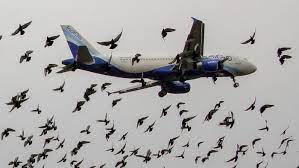NEW DELHI, Mar 27: Indian airports saw a significant increase in bird and animal strike incidents in 2021, notwithstanding the limited number of flights operating in the country last year due to coronavirus-induced travel restrictions.
Bird and animal strike incidents are considered one of the most potent threats to flight operations.
In August 2019, a flock of seagulls struck the engines of Ural Airlines’ Moscow-Simferopol flight, following which the plane crash landed in a cornfield, injuring 74 passengers.
There were 1,466 bird strike incidents (27.25 per cent increase) and 29 animal strike incidents (93.33 per cent increase) in 2021 across Indian airports as compared to 2020, according to aviation regulator DGCA’s data that has been accessed by PTI.
When figures of 2021 are compared with figures of pre-pandemic year 2019, the increase in bird and animal strike incidents at the Indian airports stand at 19.47 per cent and 123 per cent, respectively.
According to government officials, one of the major factors behind the increase in the number of bird and animal strike incidents in India during 2021 could be that the airports were quieter than usual due to limited number of flights amid the second wave of the COVID-19 pandemic.
Quieter airports attract more birds and animals, they noted.
The second COVID-19 wave had hit India hard in April-June period of 2021. The number of monthly domestic passengers dropped to just 21.15 lakh in May 2021 and only around 10 per cent of international flights were operating in India during April-June 2021 period, the officials stated.
According to the data of the Directorate General of Civil Aviation (DGCA), in 2020, there were 1,152 bird strike and 15 animal strike incidents at the Indian airports.
In 2019, there were 1,227 bird strike and 13 animal strike incidents, and in 2018, there were 1,214 bird strike and 19 animal strike incidents at the Indian airports, the data stated.
The DGCA, in a 2018 circular, had said that the presence of wildlife on and in vicinity of an airport poses a “serious threat” to aircraft operational safety.
When PTI asked the Centre-run Airports Authority of India (AAI) reasons for the significant increase in such incidents during 2021, it replied that the “main reason” for these incidents is “urbanisation around the airport, improper waste management, butcheries near the airport, open drains in surrounding areas etc. Which are the main source of attraction of food or water for birds or animals”.
At the AAI-run airports, during the year 2019-20 the bird strike incidents were 276 and animal strike were 12 whereas during during the year 2020-21 the bird strike incidents were 225 and animal strike incidents were five, it said.
“It can be seen that during these years there is no increase in the bird strike and animal strike incidents at the AAI-run airports,” it added.
The AAI runs more than 100 airports across the country. However, major airports such as in Bengaluru, Hyderabad, Delhi, Mumbai, Ahmedabad, Guwahati, Jaipur, Lucknow, Mangaluru and Thiruvananthapuram are run by private operators.
The AAI said it has taken multiple steps to reduce bird and animal strike incidents at its airports.
In order to reduce or control these incidents within AAI-run airports, bird scaring devices such as zone gun, laser torch, sound repellent device, reflective tapes etc. Are being used, it mentioned.
In addition to this, the operational area is levelled and graded, grass and bushes are regularly cut, insecticide is regularly sprayed, rodent control measures are undertaken, garbage is disposed off in proper covered area and is not exposed to birds, and the drains are covered with nets, it stated.
Workshops are organised for ornithology and natural history for sensitising airport officials who have to take measures to control bird and animal strike incidents, it noted.
Based on ecological studies conducted, the AAI has started doing “netting, trapping and relocation” for urban birds such as the Blue Rock pigeon.
“The birds are relocated at least 50 km away from the airport, because pigeons are known for their strong homing,” the AAI noted.
Insecticides are being used to reduce insect activity level which are the main source of food for birds, it mentioned.
Open soil patches — which are most suitable for the breeding of ground nesting birds such as lapwings — have been removed, it said.
Further, the growth of grass at airside is maintained at an average height of 15-20 cm within the airport, it mentioned.
“Periodic removal of eggs and nests from the airport can disturb the birds. Hence, eggs and nests are being collected regularly until breeding efforts of birds are abandoned,” it said.
Holes in the airports’ perimeter walls have been covered to stop entry of jungle cats, jackals, snakes, amphibians and small mammals, it noted.
Spikes have been installed over signages and poles near the runway to avoid perching of birds, it said.
Airfield Environment Management Committee (AEMC) meetings chaired by senior officials of state authorities are being conducted to adopt measures for controlling the presence of birds and animals on or in the vicinity of airport, it mentioned.
Regular inspection is carried out with local municipal authorities in the vicinity of airport to take measures so as to reduce the bird and animal strike incidents, it said. (PTI)
Trending Now
E-Paper


